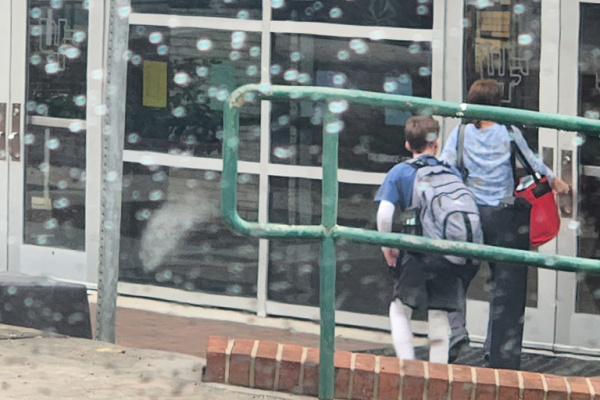Our journey to secure school accommodations for our son with EB
A columnist is pleased by recent efforts to arrange high school accommodations
Written by |

When our son Jonah, who was born with epidermolysis bullosa (EB), was 3 years old, our requests for educational support and therapeutic services were denied for a second time by our school district. I was distraught.
At that time in our state, when children with special needs turned 3, they passed from the care of early intervention to the local school system. In the process, they were evaluated to determine which, if any, educational support services they qualified for.
Until that point, all of Jonah’s therapies had been covered through early intervention. But because of the school district’s denial, he now qualified for nothing. I had to fight to find a three-hour preschool that would even consider taking him.
Because of Jonah’s EB, risks at school included being bumped or stepped on by other children, getting hurt while trying to do basic tasks such as cutting and gluing crafts, tripping while running on the playground, and even dancing with his friends during circle time. Being so fragile without a nurse or a one-on-one aide made Jonah a liability.
In that meeting when he was denied for a final time, after we had presented all of the doctors’ letters and paperwork to try to get Jonah what he needed, we were told that he didn’t qualify for services under one of the categories of disability in the Individuals with Disabilities Education Act, called “Other Health Impairment.” This category is designed for children who may not fit the mold of a typical intellectual disability.
In the opinion of administrators, Jonah was too smart to get help, could navigate the classroom setting just fine, and needed no specialized instruction. I recall angrily thinking (and perhaps even saying), “So do I need to shove his face into the ground so that you can see what’s going to happen when he falls down? And are you going to tube-feed him during the day, or are we expecting his teachers to do that? What about when he’s absent for days at a time because of corneal abrasions? Who’s going to do his wound care during the day?” I was furious.
With no other recourse, Jonah ended up at a private school. It had small class sizes, which lessened his risk of getting hurt. Classes were only a half day, so I could pick him up at noon and do his G-tube feeding at home. Then I could do his bath and bandage change in the afternoons.
Could I also be employed and earn a salary for my family while doing this? No. Would I be his sole caregiver with no therapies or support services to speak of? Apparently, that was our only option. It wasn’t until Jonah reached second grade that we qualified for North Carolina’s CAP/C Medicaid program and finally got some help.
Obviously, we are thankful for the school where Jonah ended up. And we were blessed to have a fund and generous relatives to help us pay for it. Many families aren’t so lucky.
A more caring and empathetic approach
When Jonah, who is now 14, graduated from that private school last year and was about to transition to a public high school, I was terrified. Would the process be a repeat of how horribly it had gone a decade ago? Would anyone care?
In early December 2022, I met Jonah’s future counselor at an orientation at the high school, and we began emailing. He was incredibly kind and responsive. It was the opposite of what we had experienced all those years before.
The counselor remained in constant contact throughout the next spring, and requested information about Jonah’s needs from his current school and nursing agency. He told me that Jonah undoubtedly needed a 504 plan — accommodations afforded by Section 504 of the Rehabilitation Act — and it shouldn’t be a problem for him to qualify.
Although the counselor is a 10-month employee, he began emailing me again at the beginning of August — two weeks before he was even supposed to be back at work — to set up a 504 plan meeting.
During the meeting, the counselor, Jonah’s vice principal, a lovely woman from the school district’s central office, and most of his teachers were in attendance. I’ve never felt so heard in my entire life. Everyone went above and beyond, building in more accommodations than Jonah will likely need to ensure he is successful in high school. Every single administrator and teacher was a treasure.

Jonah walks into his high school on the first day of classes last week. (Courtesy of Patrice Williams)
Jonah has just completed his first full week of ninth grade. Everyone has gone out of their way to make him feel seen and cared for. From the media coordinator who told him to come hang out in the library whenever he wants to the varsity basketball coach who invited him to help manage the team this winter, to his health teacher who said he would assign seats for the entire class if it meant Jonah could get a “safe” seat where he wouldn’t get bumped, the love and compassion shown to him have been incredible.
He is being so well loved. And, truly, I could not ask for more.
Note: Epidermolysis Bullosa News is strictly a news and information website about the disease. It does not provide medical advice, diagnosis, or treatment. This content is not intended to be a substitute for professional medical advice, diagnosis, or treatment. Always seek the advice of your physician or other qualified health provider with any questions you may have regarding a medical condition. Never disregard professional medical advice or delay in seeking it because of something you have read on this website. The opinions expressed in this column are not those of Epidermolysis Bullosa News or its parent company, Bionews, and are intended to spark discussion about issues pertaining to epidermolysis bullosa.







Leave a comment
Fill in the required fields to post. Your email address will not be published.